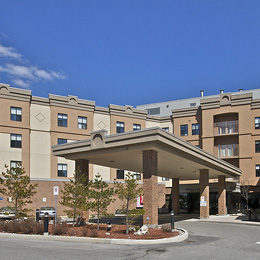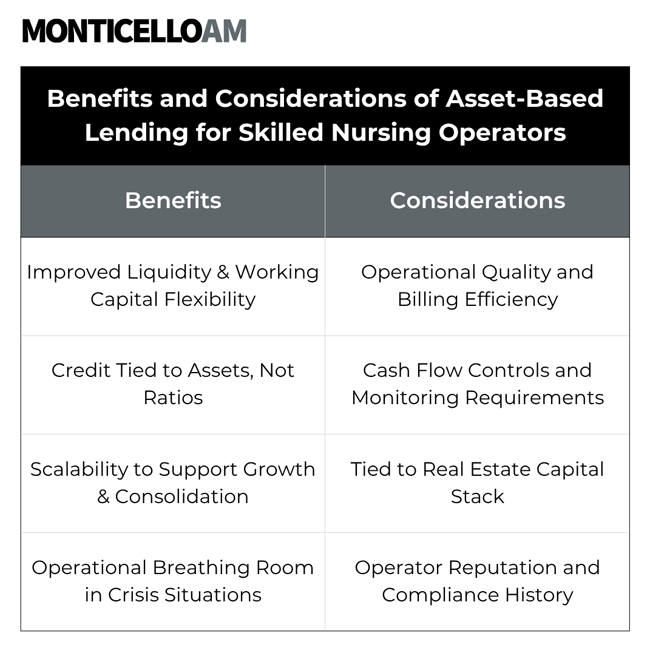
For owners and operators of skilled nursing facilities (SNFs), weathering uncertainty becomes second nature. From regulatory to operational aspects of the industry, there are numerous moving parts that can quickly shift at a moment's notice. Adaptability becomes an essential skill to develop, and along with that, the tools to help them manage sudden changes need to be flexible as well.
In healthcare, the line of credit is based on reimbursements from Medicare, Medicaid, insurance, or similar eligible third-party payments that patients use to help pay for their stay in a skilled nursing facility. Lenders analyze those eligible receivables to determine the line of credit size for the borrower, which helps bridge the gap between when the patient is billed and when the funds are received.
At its core, healthcare ABL provides the critical liquidity to manage the day-to-day operational needs that come with running a skilled nursing facility to prepare for situations like delays in third-party reimbursements, rising operational costs, occupancy rate fluctuations, and labor turnover.
Day-to-Day Operational Expenses
Let’s take a closer look at the biggest areas SNF operators are using ABL to mitigate the impact of industry-related changes:
Delays in Reimbursements: It’s common when SNF operators bill their patients; reimbursement from Medicare, Medicaid, insurance, or any eligible third-party payment could take 30 and up to 90 days. Between the billing and the reimbursement cycle, payroll, vendor payments, and other day-to-day operational expenses still need to be paid, which makes liquidity from ABL loans essential for facilities to meet those cash-flow needs and remain on track operationally.
Rising Operational Costs: As non-labor operational costs like supplies, food, and insurance have been trending up, SNF operators can’t immediately offset those expenses by raising prices. This leads to a bigger need for a flexible form of financing to cover price increases and maintain margins.
Occupancy Rate Fluctuations: Facility occupancy plays a big part in how SNFs secure financing. Occupancy is essential in bringing in the necessary cash flow to run the business and pay off any outstanding debt obligations. If a facility experiences a dip in occupancy, the line of credit can be a lifeline to make sure bills are continuing to be paid while the facility works to bring occupancy back up.
Labor Shortages and Turnover:One of the biggest priorities in skilled nursing is ensuring there are adequate staff to take care of the facility’s patients. Staffing mandates require a certain nurse-to-patient ratio, so if that isn’t met, SNFs turn to agencies that can provide a quick solution. ABL financing has often been used to make up for that short-term spike in cost, as agency staffing is commonly more expensive than hiring an in-house employee.

The Benefits and Considerations of ABL for SNF Operators
In today’s skilled nursing environment—where rising labor costs, regulatory complexity, and shifting reimbursement models continue to challenge operators—access to reliable capital is more than just a competitive advantage. It’s essential. At MONTICELLOAM, we see firsthand how ABL is a critical tool for SNF owners and operators to manage operational stability, bridge cash flow gaps, and grow responsibly.
Let’s take a look at the benefits and considerations operators are weighing when they utilize ABL for their facility:
Improved Liquidity & Working Capital Flexibility: ABL structures provide immediate access to working capital by advancing funds against eligible receivables—primarily from Medicare, Medicaid, and insurance. This improves day-to-day financial flexibility, allowing operators to stay current on payroll, vendor obligations, and property-level investments without being dependent on delayed reimbursements or fluctuating census.
Credit Tied to Assets, Not Ratios: Traditional credit facilities rely heavily on borrower financial ratios like debt service coverage, current ratio, or net income—metrics that may not accurately reflect operational strength, especially in periods of transition. ABL shifts the focus to the value and quality of underlying assets, particularly receivables, offering a path to capital for otherwise creditworthy operators who may be in a turnaround or transition phase.
Scalability to Support Growth & Consolidation: For operators going after acquisitions or portfolio expansions, ABL can scale in tandem with receivables growth. It serves as a valuable acquisition tool, especially when acquiring underperforming assets with potential upside. Additionally, ABL can coexist with long-term real estate financing, creating a capital stack that supports both operations and long-term investment.
Operational Breathing Room in Crisis Situations: Whether it’s COVID-19, unexpected regulatory changes, or localized disruptions, ABL can serve as a critical buffer during unplanned stress events. This responsive capital helps operators to maintain continuity of care and avoid reactionary cost-cutting strategies that could impact their residents.
Considerations for SNF Operators and ABL Lenders
While ABL is a powerful tool, it comes with important considerations that both lenders and operators must weigh to ensure long-term success. Below are examples of the factors that ABL partners should understand and be aligned on.
Operational Quality and Billing Efficiency: The quality of an operator’s internal billing and collections process has a direct impact on the performance of a working capital facility. Inconsistent or delayed billing, poor documentation, or lack of payer diversification can reduce eligible collateral. Lenders should conduct thorough due diligence on the operator’s receivables management processes.
Cash Flow Controls and Monitoring Requirements: To protect collateral and repayment, lenders have certain controls and requirements set up for full visibility on when and where the receivables are directed. These mechanisms can be complex for operators unfamiliar with the detailed process and reporting requirements, making it important to establish clear protocols and communication from the beginning of the relationship.
Tied to Real Estate Capital Stack: Many ABL credit lines are structured alongside a senior mortgage loan. Operators should work with partners who have experience in structuring healthcare deals with multiple capital layers. At MONTICELLOAM, a benefit of our comprehensive financing capabilities is that we can provide solutions for our clients across the capital stack to meet their needs.
Operator Reputation and Compliance History: The reputation and clinical performance of the SNF operator play an integral role. Facilities with a history of fines, lawsuits, or care deficiencies present elevated risk—both financially and reputationally. Experienced ABL lenders will assess not just the numbers, but the operator’s track record and leadership capability.
Customized Working Capital Solution for a Large Skilled Nursing Operator
When a major multi-state skilled nursing operator looked to MONTICELLOAM for a $400 million bridge loan, immediate access to working capital was a large priority as they manage a portfolio of over 29 SNFs. Our team was able to work with the borrower’s finance and operations teams to structure $22 million in ABL financing by reviewing their receivables and cash flow needs while consolidating their various existing lines of credit to simplify the cash flow stream.
This line of credit provided them with the much-needed flexibility to support day-to-day operations and navigate regulatory transitions in multiple states.
We recognize that skilled nursing ABL isn’t all about the numbers — it's about maintaining care, supporting staff, and sustaining the long-term future of healthcare facilities.
This transaction highlights how MONTICELLOAM approaches working capital needs for our skilled nursing clients: through an examination of a borrower’s receivables, reimbursement streams, and cash flow needs and leveraging deep sector fluency to tailor a solution that helps them achieve their immediate and long-term goals.
Selecting the Right Partner
For skilled nursing operators, selecting the right asset-based lender is just as important as the structure itself. A partner experienced in healthcare understands the nuances of third-party reimbursements, state-specific Medicaid programs, Medicare, and the operational cadence of care delivery.
Operators should ask prospective lenders:
- Do you have experience with CMS reimbursement cycles and Medicare/Medicaid audits?
- How do you evaluate eligibility of receivables?
- Can the facility’s real estate or other assets be integrated into the ABL structure?
- How quickly can capital be deployed?
- What reporting or compliance requirements are expected?
ABL as a Strategic Tool for Healthcare
In the skilled nursing industry, access to responsive, adaptable capital can make all the difference. It offers operators the flexibility to manage real-time challenges while laying the foundation for immediate and long-term success.
Our firm offers a comprehensive toolkit of financing solutions—including ABL, bridge, mezzanine, and permanent financing—paired with deep sector expertise, enabling clients to find the right capital structure to execute their business plan.
We believe that ABL is more than a product – it’s truly a partnership. By understanding the realities of skilled nursing operations and structuring capital accordingly, capital partners help operators deliver quality care while maintaining financial strength.